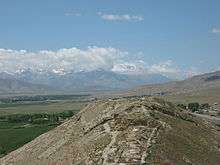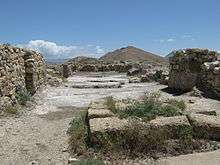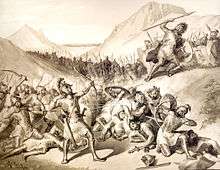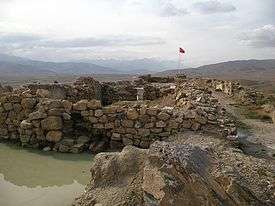Haykaberd
| Haykaberd Հայկաբերդ Çavuştepe | |
|---|---|
| Gürpınar, Van, Turkey | |
|
The ruins of Urartian Sardurihinilli. | |
 Haykaberd Հայկաբերդ Çavuştepe | |
| Coordinates | 38°21′09″N 43°27′34″E / 38.352443°N 43.459393°E |
| Type | Fortified City |
| Site history | |
| Built | 1st millennium BC |
| Built by | Sarduri II |
| Materials | Stone |
| Demolished | Partially |
Haykaberd (Armenian: Հայկաբերդ; meaning "Fortress of Hayk"; Kurdish: Aspeşîn; Turkish: Çavuştepe) or Sardurihinilli is an ancient fortified site in the Gürpınar district of Van Province in Turkey's Eastern Anatolia region. It is located approximately 25 kilometers southeast of Van along the road leading to the city of Hakkâri, in a valley once known as Hayots Dzor (Armenian: Հայոց Ձոր; "Valley of the Armenians") in historic Armenia. It was used by the Urartian kings as a fortress during the 8th century BC.
In Armenian folklore it is the fortress built by Hayk, the legendary founder of the Armenian nation, close to the site where he slew the invading Babylonian King Bel or possibly Nimrod.
Site


Sarduri-Hinilli has a linear plan, perched upon a ridge overlooking the Gürpınar Plain. It is composed of fortification walls as well as the remains of an Urartian royal palace, built between 764 and 735 BC during the reign of King Sarduri II (764-735 BC) at the climax of power of the Urartian Empire. There are upper and lower sections of the fortress in which the Temple of Khaldi, citadel walls, king's tower, workshops (7th century BC), storehouses, cisterns, kitchen, palace with a throne room, "royal" toilet, harem and colonnaded halls were located. A moat surrounded sections of the fortress.
Sarduri-Hinilli was destroyed in the 7th century BC, presumably by the Scythians. Traces of a later medieval occupation exists. The site was excavated between 1961 and 1986 by Afif Erzen.
In folklore
Hayk and King Bel
In Movses Khorenatsi's account, Hayk, son of Torgom, had a child named Armanak while he was living in Babylon. After the arrogant Titanid Bel made himself king over all, Hayk emigrated to the region near Mount Ararat with an extended household of at least 300 and settled there, founding a village he named Haykashen. On the way, he had left a detachment in another settlement with his grandson Kadmos. Bel sent one of his sons to entreat him to return, but was refused. Bel decided to march against him with a massive force, but Hayk was warned ahead of time by Kadmos of his pending approach. He assembled his own army along the shore of Lake Van and told them that they must defeat and kill Bel, or die trying to do so, rather than become his slaves. In his writings Movses states that:
| “ | Hayk was a handsome, friendly man, with curly hair, sparkling eyes, and strong arms. He was a man of giant stature, a mighty archer and fearless warrior. Hayk and his people, from the time of their forefathers Noah and Japheth, had migrated south toward the warmer lands near Babylon. In that land there ruled a wicked giant, Bel. Bel tried to impose his tyranny upon Hayk’s people. But proud Hayk refused to submit to Bel. As soon as his son Aramaneak was born, Hayk rose up, and led his people back to the land of his forefathers, the land of Ararat. At the foot of the mountains, he built his home, Haykashen.[1] | ” |
The Battle of the Giants and Defeat of Bel

Hayk and his men soon discovered Bel's army positioned in a mountain pass (Moses of Chorene located the site as Dastakert), with the king in the vanguard.
At Dyutsaznamart (Armenian: Դյուցազնամարտ, "Battle of Giants"), near Julamerk southeast of Lake Van, on August 11, 2492 BC [2] (according to the Armenian traditional chronology) or 2107 BC (according to "The Chronological table" of Mikael Chamchian), Hayk slew Bel with a nearly impossible shot using a long bow, sending the king's forces into disarray.
The hill where Bel with his warriors fell, Hayk named Gerezmank meaning "tombs".[3] He embalmed the corpse of Bel and ordered it to be taken to Hark where it was to be buried in a high place in the view of the wives and sons of the king.
Soon after, Hayk established the fortress of Haykaberd at the battle site and the town of Haykashen in the Armenian province of Taron (modern-day Turkey). He named the region of the battle Hayk, and the site of the battle Hayots Dzor [4]
References
- ↑ (Khorenatsi, History\\ I.10-12)
- ↑ dated by Mikayel Chamchian; Razmik Panossian, The Armenians: From Kings And Priests to Merchants And Commissars, Columbia University Press (2006), ISBN 978-0-231-13926-7, p. 106.
- ↑ Gerezmank: the nom. pl, Gerezmans being acc. pl., "tombs"
- ↑ History 1.11; a district to the southeast of Lake Van, see Hubschmann, AON, p.343
Sources
- O. Belli (2001): Çavuştepe (Šardurḫinili) Excavations. In: O. Belly (ed.): İstanbul University’s Contributions to Archaeology in Turkey 1932-2000. Istanbul, pp. 173–178.
- A. Erzen (1978): Çavuştepe I. M. Ö. 7.-6. Yüzyil Urartu Mımarlik Antilari ve Ortaçağ Nekropolü . Ankara.
- A. Erzen (1978): Ausgrabungen auf der urartäischen Burg Çavuştepe im Gebiet von Van. In: E. Akurgal (ed.): The Proceedings of the Xth International Congress of Classical Archaeology, Ankara-İzmir, 23-30.9.1973. Ankara, pp. 55–59.
